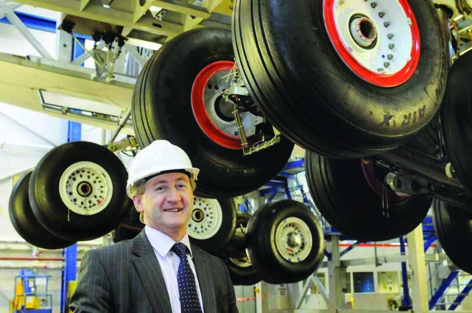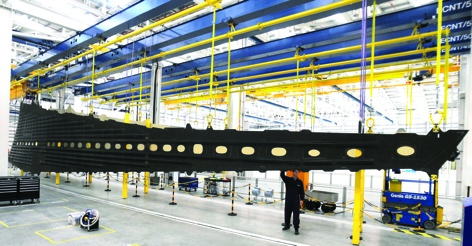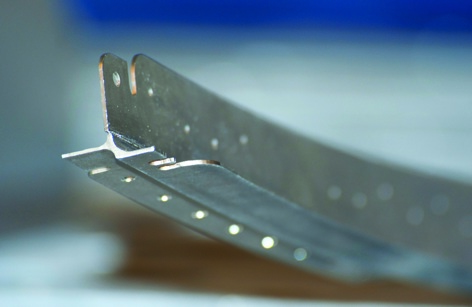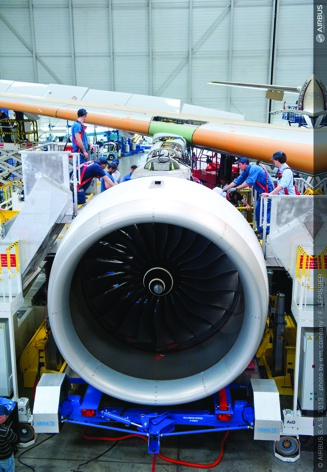
Every civil Airbus in the air is flying on wings that were made in the UK — at the company’s huge Broughton facility, to be precise. It’s one of the major factors that has earned the UK’s aerospace industry second position in the world, behind the US and ahead of France and Germany, a fact that probably escapes the majority of the general public.
Maintaining that position is, naturally, very important to those in the sector, and Airbus’s UK division is among a group of aerospace companies that is supporting a bursary for students to study for an Aerospace Engineering MSc at a variety of British universities. The bursary fund, totalling £6m, is being put up by BIS and other firms in the sector, including Rolls-Royce, BAE Systems and MBDA.
But according to Airbus UK engineering director Neil Scott, this is just a matter of a place in a league table. ‘We want to hold our competitive edge, but to do that, we need to continually develop our capability in engineering, because that is absolutely central to everything we do.’
Airbus’s centre of engineering is at Filton, just outside Bristol, where around 2,000 engineers work in the company’s design office in areas such as wing integration, flight physics, structures and systems. ‘If you look at all the work we do, and include our direct supply chain, the total number of people in the UK whose jobs depend directly upon Airbus is 110,000 — and all of those come from those 2,000 people at Filton,’ Scott said; moreover, there are several thousand indirect jobs. ‘Everything in manufacturing as well as in the supply chain emanates directly from those engineering activities.’

This, he says, demonstrates the importance of investment in engineering — something of which he feels the MSc Bursary is a direct example. ‘That consequence of investing in excellence is very important to us — that if you invest in the right engineering in the right sectors, like commercial aerospace, then you get this massive leverage, this huge multiplier effect right across the country and a direct benefit to the UK economy.’
The MSc bursary is needed to help improve skills in aerospace ‘across the entire engineering field,’ Scott said. ‘If you’re going to be a chartered engineer, a Masters is required these days, so that gives you the level of capability that we need,’ he said. ‘And we need skilled engineers in every part of our business.’
Research and development is an important part of this, but it’s not the only priority. ‘To take composite structures, for example, we need engineers there in the development area, for certain. The A350’s composite wing is in ongoing development at the moment. But we also need people to support other composite wing systems, such as the A400M, which is about to go into service with the French Air Force. So when we get composite engineers, depending on their skill and aptitude, we put them into the appropriate arena.’
Scott picked out composites because, he said, it’s by far the biggest growth area in aerospace engineering at the moment, particularly for Airbus in the UK with its focus on wings. ‘The interest in composites goes across the whole aerospace area,’ he explained. ‘As you move onto getting the last percentage points of performance improvement in an aircraft, one of the main things you look at is weight, and composites help you both with that and with increasing the longevity of the aircraft.’
Having said that, it’s far from the only area that Airbus’s engineering is concerned with. ‘We have specialisms in areas such as avionics systems development — systems architects as we call them — and in fatigue and damage tolerance, and in stress engineering across metallics and composites.’
Metals remain important in civil aerospace despite Airbus and Boeing’s incorporation of greater quantities of composites in their new airliners. ‘We look at aluminium, titanium, and even stainless steel,’ Scott said. ‘We don’t stop, because if you stop looking at a technology you’ll miss something.’

Even on a large composite structure such as a modern airliner wing, there will still be places where metallic components are the only sensible option. ‘Where you need a high-strength fitting but you don’t have a lot of volume available you need to limit the bulk of the component, such as pickups on pylons or on very highly stressed areas like landing gear, then we need to look at titanium or stainless. To use composites in those areas and get the strength you need, the sheer volume of material you’d need would be far too big.’
Airbus is at the forefront of investigating the use of 3D printing — additive layer manufacturing, or ALM — to produce such metal components. ‘It’s an interesting area,’ Scott said. ‘We’re using high-strength materials like titanium, and we do take ALM components and put them onto our flight-test aircraft to see how they perform and get the feedback about their structural capability. But what we haven’t done is to move from the very small into much larger components.’
One of Airbus’s stated long-term aims is to eventually use ALM to print very large components — even complete wings. ‘But if you’re going to do that there’s a huge advancement needed, not just in the structure of the wing itself, but in the capability of the machines you’d need,’ Scott said. ‘Developing the capability to use ALM is actually more challenging than designing the components to be made using ALM.’
Aerospace techniques such as lightweighting are now finding their way out of the sector, gathering much interest from the automotive sector, for example: make a car lighter, and you can use a smaller engine, burning less fuel, without sacrificing performance. According to Scott, the information exchange is a two-way street. Demand for aircraft is growing, he explained, especially from fast-growing economies such as India and Brazil. ‘We have to think about putting higher volumes out there, and nobody has more experience of engineering at high volumes than automotive. So when it comes to designing for volume, manufacturability and rapid assembly, we can learn a lot from automotive where we don’t have the expertise in-house.’

Meanwhile, Airbus’s engineers are working on a variety of development projects, one of the largest of which concerns the A320 wing. ‘We have the programme with the A320NEO [new engine option]; that’s a huge development, particularly for us in the UK, because when you change the engine there are major implications for the wing structure,’ he said. ‘A lot of the components change, and we’ve also put a sharklet on the end of the wing to improve aero-dynamic performance. We’ve sold over 1,500 of those aircraft, so it’s a big project for us.’
The company’s established workhorse, the A330, is also the subject of continuing development. ‘We’re looking to make increments to aspects of performance such as the max take-off weight,’ Scott said. ‘And although we’re not doing development work on the A380 at the moment, we need to support it in service. It all represents continuous challenges for our engineers.’





Red Bull makes hydrogen fuel cell play with AVL
Formula 1 is an anachronistic anomaly where its only cutting edge is in engine development. The rules prohibit any real innovation and there would be...